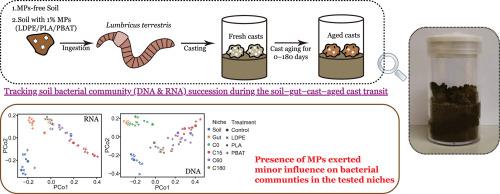当前位置:
X-MOL 学术
›
Soil Biol. Biochem.
›
论文详情
Our official English website, www.x-mol.net, welcomes your
feedback! (Note: you will need to create a separate account there.)
Microplastics exert minor influence on bacterial community succession during the aging of earthworm (Lumbricus terrestris) casts
Soil Biology and Biochemistry ( IF 9.8 ) Pub Date : 2024-05-24 , DOI: 10.1016/j.soilbio.2024.109480 Ke Meng , Paula Harkes , Esperanza Huerta Lwanga , Violette Geissen
Soil Biology and Biochemistry ( IF 9.8 ) Pub Date : 2024-05-24 , DOI: 10.1016/j.soilbio.2024.109480 Ke Meng , Paula Harkes , Esperanza Huerta Lwanga , Violette Geissen

|
The soil microbiome, which is shaped by gut-related activities of earthworms, is affected by microplastic contamination. However, the influence of microplastics on earthworm gut and cast microbiomes has been poorly explored. Here, we investigated the influence of microplastics (1% in soil, w/w) on soil physicochemical properties and bacterial communities during gut passage and cast aging of . Microplastics used in agricultural film production were selected, i.e., low density polyethylene, polylactic acid and polybutylene adipate terephthalate (PBAT). Different niches, including pre-ingestion soil, gut content and aged casts (from 0 to 180 days), were studied. Results showed that microplastics possibly enhanced the gut passage-derived difference between pre-ingestion soil and fresh cast in terms of pH, ammonium, nitrate and nitrite, and dissolved organic carbon. But such effects mostly faded out after 180 days of aging. The composition, as well as the alpha and beta diversity of both the total (DNA) and active (RNA) bacterial communities were decisively shaped by their niche (R: 0.22–0.63, p < 0.001, PERMANOVA), rather than the presence/absence or the types of MPs. Nevertheless, biomarkers indicative of PBAT treatment were identified, and functional prediction for the active community showed that bacterial communities of this treatment had higher potentials for hydrocarbon degradation (4.9–7.8 times that of the microplastic-free treatment in gut and aged casts). We also identified a “Soil-related core community” and a “Gut-related core community” (contributing to 39.2%–50.2% of the cast microbiome), which possibly neutralized microplastic impacts and maintained the structure and function of bacterial communities during the soil–gut–cast transit. Our findings indicate that the tested microplastics exerted a minor influence on the bacterial communities during the cast aging process, microplastics in aged casts might not necessarily have significant additional influence on the soil microbiome when they are incorporated into soils. Future studies testing different soils, polymers, and earthworm species, under field conditions are recommended to help enhance current knowledge of the influence of microplastics on earthworm cast microbiomes.
中文翻译:

微塑料对蚯蚓(Lumbricus terrestris)铸件衰老过程中细菌群落的演替影响较小
由蚯蚓肠道相关活动形成的土壤微生物组受到微塑料污染的影响。然而,微塑料对蚯蚓肠道和铸型微生物组的影响却鲜为人知。在这里,我们研究了微塑料(土壤中 1%,w/w)在肠道通过和铸件老化过程中对土壤理化性质和细菌群落的影响。选择用于农膜生产的微塑料,即低密度聚乙烯、聚乳酸和聚己二酸对苯二甲酸丁二醇酯(PBAT)。研究了不同的生态位,包括摄入前的土壤、肠道内容物和老化管型(0 至 180 天)。结果表明,微塑料可能增强了摄入前土壤和新鲜铸件之间在 pH、铵、硝酸盐和亚硝酸盐以及溶解有机碳方面的肠道通道差异。但这种效应大多在老化180天后逐渐消失。总 (DNA) 和活性 (RNA) 细菌群落的组成以及 α 和 β 多样性是由它们的生态位决定性的(R:0.22-0.63,p < 0.001,PERMANOVA),而不是存在/缺席或议员的类型。尽管如此,确定了指示 PBAT 处理的生物标志物,并对活跃群落的功能预测表明,这种处理的细菌群落具有更高的碳氢化合物降解潜力(肠道和老化铸件中无微塑料处理的 4.9-7.8 倍)。我们还确定了“与土壤相关的核心群落”和“与肠道相关的核心群落”(占铸型微生物组的39.2%–50.2%),它们可能中和微塑料的影响并在微生物群落期间维持细菌群落的结构和功能。土壤-肠道-铸造转运。 我们的研究结果表明,测试的微塑料在铸件老化过程中对细菌群落产生轻微影响,老化铸件中的微塑料在融入土壤时不一定会对土壤微生物组产生显着的额外影响。建议未来研究在现场条件下测试不同的土壤、聚合物和蚯蚓物种,以帮助增强目前对微塑料对蚯蚓粪微生物组影响的了解。
更新日期:2024-05-24
中文翻译:

微塑料对蚯蚓(Lumbricus terrestris)铸件衰老过程中细菌群落的演替影响较小
由蚯蚓肠道相关活动形成的土壤微生物组受到微塑料污染的影响。然而,微塑料对蚯蚓肠道和铸型微生物组的影响却鲜为人知。在这里,我们研究了微塑料(土壤中 1%,w/w)在肠道通过和铸件老化过程中对土壤理化性质和细菌群落的影响。选择用于农膜生产的微塑料,即低密度聚乙烯、聚乳酸和聚己二酸对苯二甲酸丁二醇酯(PBAT)。研究了不同的生态位,包括摄入前的土壤、肠道内容物和老化管型(0 至 180 天)。结果表明,微塑料可能增强了摄入前土壤和新鲜铸件之间在 pH、铵、硝酸盐和亚硝酸盐以及溶解有机碳方面的肠道通道差异。但这种效应大多在老化180天后逐渐消失。总 (DNA) 和活性 (RNA) 细菌群落的组成以及 α 和 β 多样性是由它们的生态位决定性的(R:0.22-0.63,p < 0.001,PERMANOVA),而不是存在/缺席或议员的类型。尽管如此,确定了指示 PBAT 处理的生物标志物,并对活跃群落的功能预测表明,这种处理的细菌群落具有更高的碳氢化合物降解潜力(肠道和老化铸件中无微塑料处理的 4.9-7.8 倍)。我们还确定了“与土壤相关的核心群落”和“与肠道相关的核心群落”(占铸型微生物组的39.2%–50.2%),它们可能中和微塑料的影响并在微生物群落期间维持细菌群落的结构和功能。土壤-肠道-铸造转运。 我们的研究结果表明,测试的微塑料在铸件老化过程中对细菌群落产生轻微影响,老化铸件中的微塑料在融入土壤时不一定会对土壤微生物组产生显着的额外影响。建议未来研究在现场条件下测试不同的土壤、聚合物和蚯蚓物种,以帮助增强目前对微塑料对蚯蚓粪微生物组影响的了解。











































 京公网安备 11010802027423号
京公网安备 11010802027423号